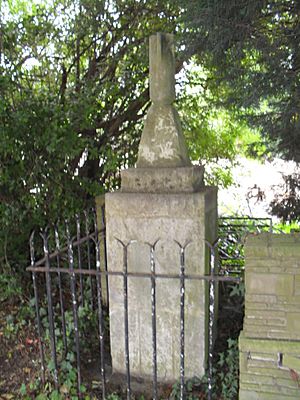Anti–Air War Memorial facts for kids

The Anti–Air War Memorial in 2011, before it was fixed up
|
|
| Location | High Road, Woodford Green, London, England |
|---|---|
| Designer | Eric Benfield |
| Material | stone |
| Opening date | 20 October 1935 |
|
Listed Building – Grade II
|
|
| Official name: Anti Air War Memorial | |
| Designated: | 22 February 1979 |
| Reference #: | 1081040 |
The Anti–Air War Memorial is a special monument found in Woodford Green, London, England. It was created and put up in 1935 by Sylvia Pankhurst, a famous activist who fought for women's right to vote and believed in socialist ideas. She wanted it to be "a protest against war in the air." This memorial is important because it was Britain's very first anti-war monument. It is officially protected as a Grade II listed building on the National Heritage List for England.
Contents
Why Was the Memorial Built?
Sylvia Pankhurst strongly believed in peace and was against war. She felt this way after seeing Zeppelin air raids on London during World War I. In 1932, she spoke out against England bombing places like Burma and India. By 1935, she was also very vocal against Mussolini's air attacks on Ethiopia.
A Protest Against Aerial Bombing
One of the messages on the memorial talks about "those who in 1932 upheld the right to use bombing aeroplanes." This is a clever way of referring to the countries at the 1932 World Disarmament Conference. At this meeting, they decided that countries could still use planes to drop bombs in wars. The sculptor of the memorial said that those who allowed bombing to continue were "politically and morally dead." He saw the memorial as their "gravestone," showing how wrong he felt their decision was.
Unveiling and Early Challenges
The memorial was first shown to the public on October 20, 1935. R. P. Zaphiro, who worked for the Ethiopian government, helped unveil it. Sylvia Pankhurst's friends, like James Ranger, were also there.
However, on its very first night, someone damaged the memorial. Later, it was even stolen! A new one was built by the original designer, Eric Benfield. This replacement was unveiled on July 4, 1936. People from many countries, including Germany, France, Hungary, Austria, British Guyana, and Ethiopia, came to this second event.
Protecting Its History
In 1979, the memorial was given a Grade II heritage listing. This means it was recognized as having special historical importance. At first, it was wrongly called the "Anti-Abyssinian War Memorial," but this was corrected in 2014 when the memorial was fixed up.
A Place for Peace Activists
In the 1980s, the memorial became a gathering spot for people who were against nuclear weapons. They would hold an annual "Peace Picnic" there. In 1985, for the memorial's 50th birthday, a local person named Sylvia Ayling organized a street march. They even re-enacted the original unveiling, with peace activist Maggie Freake playing the main role.
Repairs and Restoration
In 1996, the stone bomb from the top of the memorial was stolen. Luckily, the police found it in Epping Forest. It was fixed and put back on top. The local council, the Borough of Redbridge, and Sylvia Pankhurst's son, Richard, paid for all the repairs.
In 2014, the memorial was fully refurbished and made to look new again. The Campaign for Nuclear Disarmament (CND) held a special re-dedication ceremony. This event happened on World Disarmament Day. Speakers included Katherine Connelly, who wrote a book about Pankhurst. A message from Sylvia's son, Richard, was also read aloud.
What Does the Memorial Look Like?
The memorial has a base, called a plinth, with a pyramid shape on top. A stone bomb is placed on the very tip of the pyramid, looking as if it has just fallen straight down onto it. The sculptor Eric Benfield designed this unique shape.
The memorial stands on land that Sylvia Pankhurst used to own. This land was across from Red Cottage, the home she shared with Silvio Corio. Even though the cottage was torn down in 1939 and new buildings have been put up over the years, the memorial has always stayed in its place.
Images for kids


